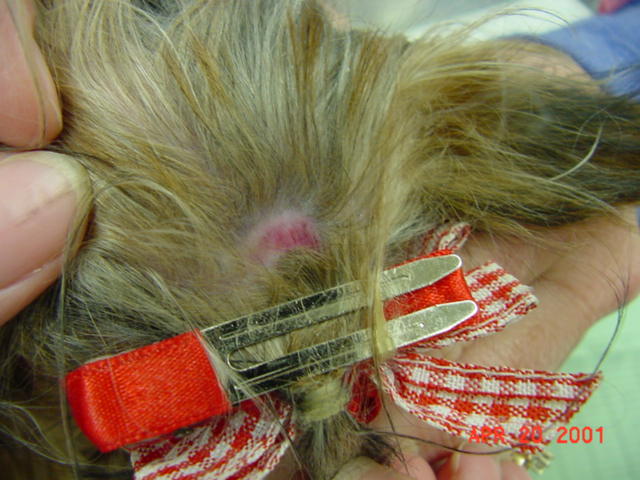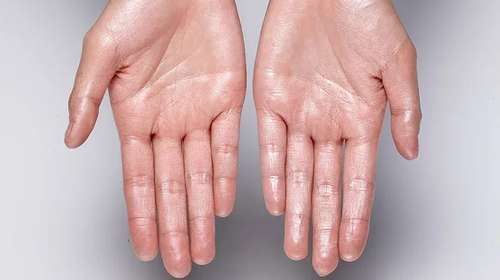It was the slap heard around the world, but as Will Smith said in a public apology the day after, jokes at his expense are just part of the job. So what really drove him over the edge? He slapped Chris Rock for making ‘a joke about my wife’s medical condition,’ a surprisingly common one that many of us are totally unfamiliar with. It’s Alopecia Awareness Month, so let’s learn!
What is Alopecia Areata?
Alopecia areata, sometimes written AA or just referred to as ‘alopecia,’ is an autoimmune disease that attacks hair follicles, leading to hair loss. Autoimmune diseases occur when the body’s immune system misidentifies your own cells as an external threat and attacks them.

A typical symptom of alopecia, a coin-sized, roughly circular patch where hair has ceased growing. (Source)
Who gets Alopecia Areata?
AA is one of the most common hair loss disorders. It affects between 0.5% and 2% of the population, without regard to gender or ethnicity. It can even affect children and adolescents, though its peak prevalence is in early adulthood. Onset triggered by puberty is less common, and is usually associated with a family history of AA. This is also usually associated with a worse prognosis involving more rapid hair loss over a greater area, with a correspondingly reduced chance of complete regrowth. In some very rare cases, even babies have been born with AA. It’s not contagious.
What causes Alopecia Areata?
There are several causes of AA but the most common is an autoimmune problem. This is when your body’s immune system sees your hair follicles as a foreign body and attacks them. Hair follicles are usually ‘immuno-privileged,’ meaning they’re outside the body’s immune system and protected from it. When that privilege is broken for some reason, AA can result. There can be other contributing causes, and not every case of spot hair loss is AA; for instance, frequent tugging on hair follicles can cause ‘traction alopecia.’

A section of scalp where frequent tugging and pressure has caused traction alopecia, which normally resolves when the traction stops. (Source)
What does AA look like?
Someone with AA will typically experience sudden-onset hair loss in a characteristic pattern. Overnight, or over a few days or weeks, you’ll see circular patches of hair loss, typically on the scalp. AA can affect any part of your body where hair grows and can be accompanied by hair loss in the eyebrows and eyelashes. Sudden graying of the hair can be a symptom too, and about 10% to 20% of AA patients have abnormal changes to their fingernails such as longitudinal streaking, circular pitting or brittle nails.
How is AA diagnosed?
A diagnosis of AA is based on the condition of your scalp. A test called trichoscopy can be used to find regularly-distributed ‘yellow dots,’ which are really ‘hyperkeratotic plugs.’ The plugs are caused when keratin, the protein used to make hair, builds up in the follicle. It’s also common to see small ‘exclamation-mark hairs’ and ‘black dots.’ These are the remains of hair follicles that have been destroyed right after opening. Sometimes a biopsy is used to look for histologic (immune system) markers. However, having discrete areas of hair loss surrounded by exclamation mark hairs can be enough to diagnose AA.

Trichoscopy is a high-magnification visualization of the scalp, used to identify characteristic hair growth patterns that can be used to diagnose alopecia. (Source)
How is AA managed?
There’s no cure for AA. But, the condition can be managed with person-centered treatment, focusing on the patient and their goals. It’s not enough to simply address hair loss in isolation. People’s differing, and usually very strong, feelings about their hair need to be accounted for.
Predicting the course of AA is difficult. New patches of hair loss can occur for about six weeks after the initial onset, which is typically not the news patients want to hear. On the other hand, it’s also normal for spontaneous regrowth to occur.
Typically, the AA prognosis is better when there are a small number of hair loss locations, covering a small total surface area, small enough to be covered by the remaining hair. In such cases, complete, spontaneous regrowth occurs within one year in 80% of patients.
More severe cases have a worse prognosis and it’s more likely that pharmacological treatment will be used. Topical and intralesional steroids are a prevalent first-line treatment. Other common topical choices include topical immunotherapy using agents that appear to work by nonspecific immune stimulation, such as anthralin or squaric acid. When topical treatment is unsuccessful, or in cases where it’s not suitable because too much of the body is affected, systemic chemotherapy can be used. This usually involves immunosuppression with steroids, methotrexate, JAK-inhibitors, or sulfasalazine. Although it does not cure the disease, chemotherapy targeting AA can help with hair regrowth.
Associated Factors
Co-occurrence with atopic dermatitis usually means a worse prognosis. Additionally, AA has been associated with autoimmune thyroid disease, pernicious anemia and type 1 diabetes.
So what should you not ask someone if you think they might have Alopecia?
Sometimes, people wonder what’s caused hair loss. It’s natural. But if Will Smith’s forehand has taught us anything it’s that alopecia can be a very emotional subject. So if someone you know has some hair loss, approach the subject carefully. Try not to ‘play 20 questions’ — starting by asking if it’s cancer, then trying to narrow it down from there, isn’t a good way to go about it. Remember you can’t catch it, but also that they’re probably quite sensitive about it!
Conclusion
Alopecia areata is a form of non-scarring hair loss with a strong autoimmune component. Clinical presentation can is highly variable, and spontaneous regrowth of hair can occur. Treatment is personalized to meet each patient’s circumstances and wishes, and ranges from topical therapy to systemic immunosuppression. AA can be highly stigmatizing, but there are excellent resources available for patients and families affected by AA. These include the American Academy of Dermatology (aad.org), Locks of Love (locksoflove.org), and the National Alopecia Areata Foundation (naaf.org).













